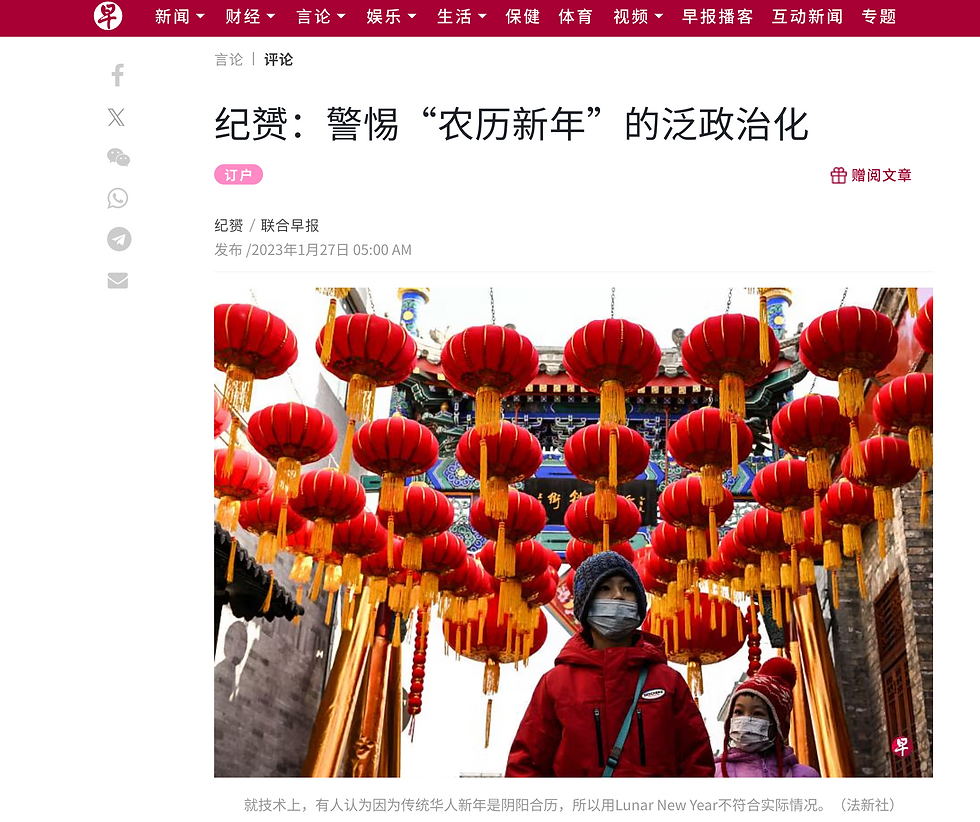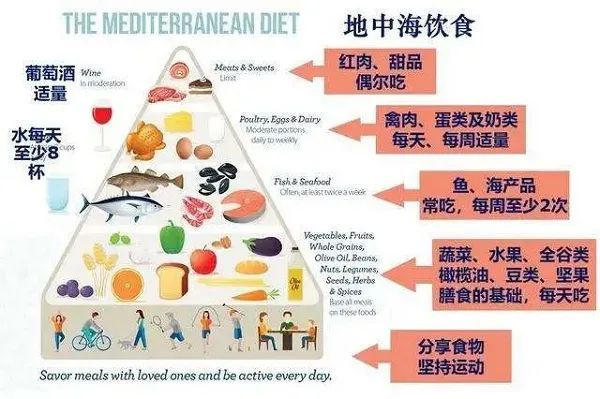TFF ThinkTank | Old Bottles With New Wine - From the CNY vs. LNY Debate to the Spring Festival UNESCO Registration Controversy
- TFF Admin
- Apr 6
- 7 min read

Today marks the first day of the Lunar New Year of the Snake. Many people may have already noticed that this Snake Year has special significance: it's the first New Year since China successfully registered the Spring Festival as UNESCO Intangible Cultural Heritage.
On December 4, 2024, China's Spring Festival was officially inscribed on UNESCO's Representative List of the Intangible Cultural Heritage of Humanity under the name "Spring Festival." This news undoubtedly affirms and recognizes this important cultural tradition. However, along with the joy came discussions about "cultural ownership" and "cultural sharing," making the significance of this UNESCO recognition far beyond just the certification of a cultural heritage.
The Spring Festival originated in China—this is a historical fact and a cultural consensus. But over thousands of years of history, the Spring Festival has long since spread beyond China's borders to become a holiday celebrated in East Asia and many countries and regions worldwide.
In recent years, every New Year triggers a major debate about the translation issue between "Chinese New Year" and "Lunar New Year." This year, with China's official UNESCO registration of the Spring Festival, the broadly "shared" cultural connotations have become more diverse, making the significance and impact of the UNESCO registration more complex.
The UNESCO registration of the Spring Festival isn't simply a dispute over cultural symbols; it involves complex issues of cultural ownership and sharing.
The Spring Festival's Origin and "Social Circle": Some Basic Understanding Needed
The Spring Festival's origins can be traced back to year-end sacrificial activities during China's Shang Dynasty. People at that time worshiped heaven, Earth, and ancestors to pray for peace and harvest in the coming year. As history progressed, the Spring Festival's meaning grew increasingly rich, gradually integrating multiple themes such as ancestor worship, harvest celebration, and warding off evil spirits, becoming a comprehensive traditional festival.
The Spring Festival is closely connected to ancient Chinese ritual systems and cultural values. For example, ancestor worship reflects the Confucian tradition that values family and filial piety; customs like hanging Spring Festival couplets and setting off firecrackers reflect people's aspirations for a better life and beliefs in dispelling evil. Therefore, the Spring Festival is not just a celebration at a specific time, but an important carrier of Chinese cultural values.
With the spread of Chinese culture, the Spring Festival gradually expanded to East Asia, taking root locally and becoming an important shared cultural memory in the East Asian cultural sphere. For instance, the Korean Peninsula calls the Lunar New Year "설날" (Seollal, which means "New Year" in Mandarin), and similar to China, this day is also an important family reunion day. People wear traditional hanbok clothing, perform ancestral worship ceremonies "차례" (Charye), and eat traditional holiday foods such as rice cake soup "떡국" (Tteokguk).

"I remember when we were young, we all looked forward to new clothes before the New Year, wearing completely new outfits on Spring Festival day. In Korea, many parents prepare hanbok for their children before the New Year. Thus, hanbok—not commonly seen in supermarkets—are prominently displayed during this time."
In Vietnam, the Lunar New Year is called "Tết Nguyên Đán" (meaning "New Year's Day" in Mandarin, often abbreviated as "Tết"), and is Vietnam's most important festival of the year. People conduct ancestral worship ceremonies, buy peach blossoms (in the north) or yellow plum blossoms (in the south) to decorate their homes, and make and eat rice dumplings "Bánh chưng" and "Bánh tét."

"Vietnamese New Year actually differs greatly from Chinese New Year in traditional customs. Vietnamese people release carp before the New Year, must eat rice dumplings during the New Year, display yellow flowers at home, and even hang nearly extinct traditional woodblock prints as New Year decorations."
Even in Japan's Okinawa, although mainland Japan switched to the Gregorian calendar New Year after the Meiji Restoration, Okinawa, more deeply influenced by Chinese culture, still maintains the custom of celebrating the Lunar New Year, called "Kyūshōgatsu" (Old New Year). Okinawans worship ancestors on this day and eat traditional holiday foods such as pork dishes.
The spread and development history of the Spring Festival shows that its cultural connotations are not static, but continuously evolve and develop in different cultural environments. This point is equally the basic understanding that should be formed when comprehending all controversies surrounding the Spring Festival.
The Old Bottle: Exactly "Whose" New Year Is It?
Based on this understanding, the question of the Spring Festival's ownership is not just an internal discussion within one country, but an international cultural issue: how to emphasize the Chinese cultural roots of the Spring Festival while respecting the cultural customs of other countries and regions, promoting cultural exchange and sharing?
In fact, this proposition itself is not a new issue. The English name of the Spring Festival has also sparked some long-existing discussions—this is what we call the "old bottle."
In recent years, there have been intense discussions online about whether the translation of Lunar New Year should be "CNY" (Chinese New Year) or "LNY" (Lunar New Year). Many internet users have posted on various simplified Chinese social platforms, essentially launching a campaign inside and outside the Great Firewall of China, trying to correct LNY in Western contexts everywhere and attempting to create the impression that all uses of LNY are translation errors.

The reason is that some people particularly link such discussions with political positioning and so-called "cultural plagiarism," as if LNY must be politically incorrect internationally. Due to cultural proximity and different ways of celebrating the Spring Festival, Korea and Vietnam have become the primary targets of this campaign. More extreme nationalists believe that the pinyin "Chunjie" should be used directly to maintain its "authentic" Chinese attributes through pinyin.
In fact, both CNY and LNY have their rationality and limitations. CNY emphasizes the Spring Festival's place of origin, helping to highlight China's position in Spring Festival culture. But for other countries and regions that also celebrate the Lunar New Year, this may seem insufficiently inclusive—with some sense of "cultural imperialism," especially considering that the voice of "CNY" has only been significantly raised in the international discourse in recent years. In comparison, LNY emphasizes the universality of the Lunar New Year but may dilute the Chinese origin of the Spring Festival.
Looking more objectively, some experts also argue that LNY itself can technically be considered an "incorrect" translation:
"The lunar calendar reconciles this contradiction through an "intercalation method," adding seven leap months every 19 years, making the average number of days close to the tropical year, both maintaining the intuitiveness of lunar phase dating and ensuring synchronization between solar terms and agricultural timing. Its scientific nature is reflected in the 24 solar terms—solar terms divided by the sun's ecliptic longitude (such as Beginning of Spring, Winter Solstice) reflect the sun's annual movement and highly match Gregorian calendar dates, essentially belonging to the solar calendar system. Therefore, translating the new year as "Lunar New Year" has a scientific expression bias. The English word "Lunar" only refers to the lunar calendar and cannot encompass the solar calendar dimension in the Chinese lunar calendar."
As for the "Chunjie" advocated by some more extreme Chinese nationalists, it is (needless to say) not only more Chinese-characterized, but also pretty difficult for international audiences unfamiliar with Chinese to understand and accept.
More importantly, in today's context—especially on the global internet—such advocacy often implies a narrow understanding of cultural dissemination. This mentality is quite common among proponents of "CNY" and "Chunjie."
Online Chinese nationalist emotions and culturally conservative ideological trends have made this view more marketable. Some people use internet platforms to advocate their cultural monopolism, attacking those who use "LNY," making this discussion more controversial.

Chinese Nationalist comment regarding
But clearly, cultural influence is not achieved through "monopoly" and "exclusion," but by displaying its unique charm through open exchange and interaction.
North Korea's Kim family's nuclear warheads and cannons obviously cannot be transformed into international influence like South Korea's K-pop; Castro's dictatorship and the US embargo couldn't prevent Cuban rum from continuing to sweep the globe as a specialty and culture. The phenomena are what they are, and the principle is what it is.
Even if we look entirely from the Chinese official's politically correct perspective of the so-called "telling China's story well," if the spread of the Spring Festival is placed purely under the logic of "cultural purity," it will undoubtedly artificially increase barriers to cultural exchange and ultimately be counterproductive.
New Wine: What to Do? Why not Celebrate Together?
When introducing Spring Festival culture, wouldn't it be better to more fully emphasize its influence in East Asia and globally, and actively invite other countries to participate in the research, protection, and promotion of Spring Festival culture?
For example, a group UNESCO application could be a better solution. Moreover, UNESCO already has successful cases of multiple countries jointly applying for World Cultural Heritage: "Mediterranean Diet" was jointly nominated by multiple Mediterranean countries (including Spain, Greece, Italy, Morocco, etc.), reflecting the shared nature and diversity of Mediterranean food culture.
Each country has its unique dietary habits and dishes, but all follow the basic principles of the Mediterranean diet—although the multiple origins of the Mediterranean diet differ from the fact that the Spring Festival originated solely in China, the shared nature formed in cultural transmission can be said to be very similar.

This "joint UNESCO application" model also provides reference for the protection of other cross-border cultural heritage. Although the UNESCO registration has already become a fait accompli with China taking the title alone, this model can be more referenced in future Spring Festival cultural promotion. Isn't it good to conduct more cooperation with countries like Korea and Vietnam, jointly emphasizing the importance of the Spring Festival as a common cultural heritage in East Asia, and showcasing each country's unique celebration methods?
The UNESCO registration of the Spring Festival is not just about protecting traditional culture, but also a microcosm of cultural exchange in the era of globalization. China has shown cultural confidence through UNESCO registration, which may be commendable in itself. But the true charm of culture lies in open exchange and interaction, not in rejecting other cultures. The value of the Spring Festival lies in its rich cultural connotations and its enormous potential as a platform for cultural exchange: wherever Asian communities go, the Spring Festival goes, and related culture can spread there.

In the era of globalization, the importance of openness and inclusiveness is self-evident, perhaps more important than any planes or cannons. At least between Asian countries, the Spring Festival perhaps shouldn't be a focus of contention, especially not a focus of contention for nationalists.
Writer: Mavis
Website Editor: Harry




Comments